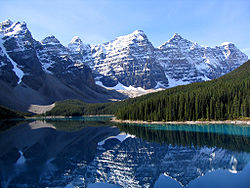
Valley of the Ten Peaks
Encyclopedia

Valley
In geology, a valley or dale is a depression with predominant extent in one direction. A very deep river valley may be called a canyon or gorge.The terms U-shaped and V-shaped are descriptive terms of geography to characterize the form of valleys...
in Banff National Park
Banff National Park
Banff National Park is Canada's oldest national park, established in 1885 in the Rocky Mountains. The park, located 110–180 kilometres west of Calgary in the province of Alberta, encompasses of mountainous terrain, with numerous glaciers and ice fields, dense coniferous forest, and alpine...
that is crowned by ten notable peaks and also includes Moraine Lake
Moraine Lake
Moraine Lake is a glacially-fed lake in Banff National Park, outside the Village of Lake Louise, Alberta, Canada. It is situated in the Valley of the Ten Peaks, at an elevation of approximately . The lake has a surface area of ....
. The valley can be reached by following the Moraine Lake road near Lake Louise
Lake Louise, Alberta
Lake Louise is a hamlet in Alberta, Canada within Improvement District No. 9 Banff . It is named for the nearby Lake Louise, which in turn was named after the Princess Louise Caroline Alberta , the fourth daughter of Queen Victoria, and the wife of John Campbell, the 9th Duke of Argyll, who was the...
. The ten peaks were originally named by Samuel Allen, an early explorer of the region, who simply referred to them by using the numerals from one to ten in the Stoney First Nations Language. He may have learnt the terms from his Native American guides, who helped him with the horses. The Nakoda - also known as the Stoney Indians - is a tribe whose culture and dialect are closely related to that of the Assiniboine First Nation, from who they are believed to have separated in the mid-1700s, and who roamed large parts of the prairies and mountains of western Alberta well into British Columbia. The secluded Valley of the Ten Peaks was part of their original homeland. Gradually, though, all but three of the mountains were renamed in honour of noteworthy individuals, including Allan himself.
Mount Hungabee
Mount Hungabee
Mount Hungabee, officially Hungabee Mountain, is a mountain located on the boundaries of Banff National Park and Yoho National Park on the Continental Divide at the head of Paradise Valley. The peak was named in 1894 by Samuel Allen after the Stoney Indian word for "chieftain" as the mountain is...
was not included in the original peak list by Allen, even though it is higher than Wenkchemna Peak, the latter of which is really an extension of Hungabee.
Peaks
The ten peaks, in order of how they are numbered from east to west, are:There are other peaks visible from within the valley as well, including Mount Temple, Mount Babel
Mount Babel (Alberta)
Mount Babel is a mountain peak of the Bow Range in Banff National Park, Alberta, Canada. The mountain can be seen from the Valley of the Ten Peaks.Mount Babel was first climbed by A Hart, E. Wheeler, L. Wilson and H. Worsfold in 1910....
and Eiffel Peak. Fay Glacier is developed between Mount Babel, Mount Fay, Mount Little and Mount Bowlen.
Note that, interestingly, the fourth summit is not accompanied by any descriptive attribute in the form of Mount, Mountain or the like.
The Valley of the Ten Peaks was featured on the reverse side of the 1969 and 1979 issues of the Canadian twenty dollar bill.
The Neil Colgan Hut
Neil Colgan Hut
The Neil Colgan Hut is an alpine hut located on the Fay Glacier in Kootenay National Park. It is situated in a col between Mount Little and Mount Bowlen, which is one of the peaks overlooking The Valley of the Ten Peaks. The hut is maintained by the Alpine Club of Canada...
, a mountaineering destination, can be reached in 8 to 12 hours climbing the Perren Route from Moraine Lake.

